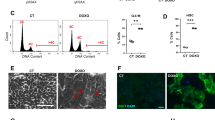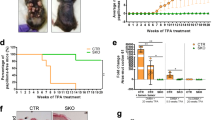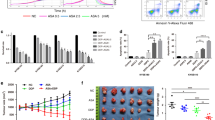Abstract
Our previous studies have shown that treatment with cigarette smoke condensate (CSC) transforms normal breast epithelial cell line, MCF-10A. In the present study, the mechanism of CSC-induced transformation of breast epithelial cells was examined. We first determined whether benzo[a]pyrene (B[a]P)- and CSC-induced levels of APC are capable of inhibiting long-patch base excision repair (LP-BER) since our earlier studies had shown that an interaction of APC with DNA polymerase β (pol-β) blocks strand-displacement synthesis. With the use of a novel in vivo LP-BER assay, it was demonstrated that increased and decreased APC levels in different breast cancer cell lines were associated with a decrease or increase in LP-BER activity, respectively. The effect of APC on LP-BER in malignant and pre-malignant breast epithelial cell lines was produced by either overexpression or knockdown of APC. Furthermore, it was shown that the decreased LP-BER in B[a]P- or CSC-treated pre-malignant breast epithelial cells is associated with an increased level of APC and decreased cell growth. Our results suggest that the decreased growth allows cells to repair the damaged DNA before mitosis, and failure to repair damaged DNA has the potential to transform pre-malignant breast epithelial cells.
This is a preview of subscription content, access via your institution
Access options
Subscribe to this journal
Receive 50 print issues and online access
$259.00 per year
only $5.18 per issue
Buy this article
- Purchase on Springer Link
- Instant access to full article PDF
Prices may be subject to local taxes which are calculated during checkout








Similar content being viewed by others
Abbreviations
- APC:
-
adenomatous polyposis coli
- B[a]P, benzo[a]pyrene, CSC:
-
cigarette smoke condensate
- LP-BER:
-
long-patch base excision repair
- pol-β:
-
DNA polymerase β
References
Bambara RA, Murante RS, Henricksen LA . (1997). Enzymes and reactions at the eukaryotic DNA replication fork. J Biol Chem 272: 4647–4650.
Baron JA . (1984). Smoking and estrogen-related disease. Am J Epidemiol 119: 9–22.
Baron JA, Newcomb PA, Longnecker MP, Mittendorf R, Storer BE, Clapp RW et al. (1996). Cigarette smoking and breast cancer. Cancer Epidemiol Biomarkers Prev 5: 399–403.
Basolo F, Elliott J, Tait L, Chen XQ, Maloney T, Russo IH et al. (1991). Transformation of human breast epithelial cells by c-Ha-ras oncogene. Mol Carcinogenesis 4: 25–35.
Braithwaite E, Wu X, Wang Z . (1998). Repair of DNA lesions induced by polycyclic aromatic hydrocarbons in human cell-free extracts: involvement of two excision repair mechanisms in vitro. Carcinogenesis 19: 1239–1246.
Cavlieri EL, Rogan RG . (1998). Mechanisms of tumor initiation by polycyclic aromatic hydrocarbons in mammals. In: Neilson AH (eds). The Hand-Book of Environmental Chemistry, vol. 3J. Springer-Verlag: Heidelberg (Germany). pp. 81–117.
Chakravarti D, Mailander P, Franzen J, Higginbotham S, Cavalieri EL, Rogan EG . (1998). Detection of dibenzo[a, l]pyrene-induced H-ras codon 61 mutant genes in preneoplastic SENCAR mouse skin using a new PCR-RFLP method. Oncogene 16: 3203–3210.
Chakravarti D, Mailander PC, Cavalieri EL, Rogan EG . (2000). Evidence that error-prone DNA repair converts dibenzo[a, l]pyrene-induced depurinating lesions into mutations: formation, clonal proliferation and regression of initiated cells carrying H-ras oncogene mutations in early preneoplasia. Mutat Res 456: 17–32.
Chakravarti D, Pelling JC, Cavalieri EL, Rogan EG . (1995). Relating aromatic hydrocarbon-induced DNA adducts and c-H-ras mutations in mouse skin papillomas: the role of apurinic sites. Proc Natl Acad Sci USA 92: 10422–10426.
Coates PJ, Lorimore SA, Wright EG . (2005). Cell and tissue responses to genotoxic stress. J Pathol 205: 221–235.
Currier N, Solomon SE, Demicco EG, Chang DL, Farago M, Ying H et al. (2005). Oncogenic signaling pathways activated in DMBA-induced mouse mammary tumors. Toxicol Pathol 33: 726–737.
DeMarini DM, Shelton ML, Levine JG . (1995). Mutation spectrum of cigarette smoke condensate in salmonella: comparison to mutations in smoking-associated tumors. Carcinogenesis 16: 2535–2542.
DeMarini DM . (2004). Mutation spectrum of cigarette smoke condensate in Salmonella: comparison to mutations in smoking-associated tumors. Mutat Res 567: 447–474.
Duell EJ, Millikan RC, Pittman GS, Winkel S, Lunn RM, Tse CK et al. (2001). Polymorphisms in the DNA repair gene XRCC1 and breast cancer. Cancer Epidemiol Biomarkers Prev 10: 217–222.
Egan KM, Stampfer MJ, Hunter D, Hankinson S, Rosner BA, Holmes M et al. (2002). Active and passive smoking in breast cancer: prospective results from the Nurses' Health Study. Epidemiology 13: 138–145.
el-Bayoumay K, Choe YH, Upadhyaya P, Rivenson A, Kurtzke C, Reddy B et al. (1995). Comparative tumorigenicity of benzo[a]pyrene, 1-nitropyrene and 2-amino-1-methyl-6-phenylimidazo[4, 5-b]pyridine administered by gavage to female CD rats. Carcinogenesis 16: 431–434.
Fink AK, Lash TL . (2003). A null association between smoking during pregnancy and breast cancer using Massachusetts registry data (United States). Cancer Causes Control 14: 497–503.
Gram IT, Braaten T, Terry PD, Sasco AJ, Adami HO, Lund E et al. (2005). Breast cancer risk among women who start smoking as teenagers. Cancer Epidemiol Biomarkers Prev 14: 61–66.
Greenblatt MS, Bennett WP, Hollstein M, Harris CC . (1994). Mutations in the p53 tumor suppressor gene: clues to cancer etiology and molecular pathogenesis. Cancer Res 54: 4855–4878.
Hamajima N, Hirose K, Tajima K, Rohan T, Calle EE, Heath Jr CW et al. (2002). Alcohol, tobacco and breast cancer – collaborative reanalysis of individual data from 53 epidemiological studies, including 58, 515 women with breast cancer and 95, 067 women without the disease. Br J Cancer 87: 1234–1245.
Hecht SS . (2002). Tobacco smoke carcinogens and breast cancer. Environ Mol Mutagen 39: 119–126.
Hsu TC, Cherry LM, Bucana C, Shirley LR, Gairola CG . (1991). Mitosis-arresting effects of cigarette smoke condensate on human lymphoid cell lines. Mutat Res 259: 67–78.
Husgafvel-Pursiainen K, Hackman P, Ridanpaa M, Anttila S, Karjalainen A, Partanen T et al. (1993). K-ras mutations in human adenocarcinoma of the lung: association with smoking and occupational exposure to asbestos. Int J Cancer 53: 250–256.
Jaiswal AS, Balusu R, Narayan S . (2006). 7, 12-Dimethylbenzanthracene-dependent transcriptional regulation of adenomatous polyposis coli (APC) gene expression in normal breast epithelial cells is mediated by GC-box binding protein Sp3. Carcinogenesis 27: 252–261.
Jaiswal AS, Bloom LB, Narayan S . (2002). Long-patch base excision repair of apurinic/apyrimidinic site DNA is decreased in mouse embryonic fibroblast cell lines treated with plumbagin: involvement of cyclin-dependent kinase inhibitor p21Waf-1/Cip-1. Oncogene 21: 5912–5922.
Jaiswal AS, Narayan S . (2001a). p53-dependent transcriptional regulation of the APC promoter in colon cancer cells treated with DNA alkylating agents. J Biol Chem 276: 18193–18199.
Jaiswal AS, Narayan S . (2001b). Upstream stimulating factor-1 (USF1) and USF2 bind to and activate the promoter of the adenomatous polyposis coli (APC) tumor suppressor gene. J Cell Biochem 81: 262–277.
Johnson KC, Hu J, Mao Y . (2000). Passive and active smoking and breast cancer risk in Canada, 1994–97. The Canadian Cancer Registries Epidemiology Research Group. Cancer Causes Control 11: 211–221.
Klungland A, Lindahl T . (1997). Second pathway for completion of human DNA base excision-repair: reconstitution with purified proteins and requirement for DNase IV (FEN1). EMBO J 16: 3341–3348.
London SJ, Colditz GA, Stampfer MJ, Willett WC, Rosner BA, Speizer FE . (1989). Prospective study of smoking and the risk of breast cancer. J Natl Cancer Inst 81: 1625–1631.
Mei J, Hu H, McEntee M, Plummer H, Song P, Wang HC . (2003). Transformation of non-cancerous human breast epithelial cell line MCF10A by the tobacco-specific carcinogen NNK. Breast Cancer Res Treat 79: 95–105.
Miller FR, Soule HD, Tait L, Pauley RJ, Wolman SR, Dawson PJ et al. (1993). Xenograft model of progressive human proliferative breast disease. J Natl Cancer Inst 85: 1725–1732.
Morabia A, Bernstein M, Heritier S, Khatchatrian N . (1996). Relation of breast cancer with passive and active exposure to tobacco smoke. Am J Epidemiol 143: 918–928.
Narayan S, Jaiswal AS . (1997). Activation of adenomatous polyposis coli (APC) gene expression by the DNA-alkylating agent N-methyl-N′-nitro-N-nitrosoguanidine requires p53. J Biol Chem 272: 30619–30622.
Narayan S, Jaiswal AS, Balusu R . (2005). Tumor suppressor APC blocks DNA polymerase beta-dependent strand displacement synthesis during long patch but not short patch base excision repair and increases sensitivity to methylmethane sulfonate. J Biol Chem 280: 6942–6949.
Narayan S, Jaiswal AS, Kang D, Srivastava P, Das GM, Gairola CG . (2004). Cigarette smoke condensate-induced transformation of normal human breast epithelial cells in vitro. Oncogene 23: 5550–5889.
Nishikawa A, Mori Y, Lee IS, Tanaka T, Hirose M . (2004). Cigarette smoking, metabolic activation and carcinogenesis. Curr Drug Metab 5: 363–373.
Pachkowski BF, Winkel S, Kubota Y, Swenberg JA, Millikan RC, Nakamura J . (2006). XRCC1 genotype and breast cancer: functional studies and epidemiologic data show interactions between XRCC1 codon 280 His and smoking. Cancer Res 66: 2860–2868.
Palmer JR, Rosenberg L . (1993). Cigarette smoking and the risk of breast cancer. Epidemiol Rev 15: 145–156.
Patel AV, Calle EE, Pavluck AL, Feigelson HS, Thun MJ, Rodriguez C . (2005). A prospective study of XRCC1 (X-ray cross-complementing group 1) polymorphisms and breast cancer risk. Breast Cancer Res 7: R1168–R1173.
Pfeifer GP, Denissenko MF, Olivier M, Tretyakova N, Hecht SS, Hainaut P . (2002). Tobacco smoke carcinogens, DNA damage and p53 mutations in smoking-associated cancers. Oncogene 21: 7435–7451.
Pillsbury HC, Bright CC . (1972). Comparison of aliquot and complete sample procedure for the determination of nicotine in cigarette smoke. J Assoc Anal Chem 55: 636–638.
Porter PC, Mellon I, States JC . (2005). XP-A cells complemented with Arg228Gln and Val234Leu polymorphic XPA alleles repair BPDE-induced DNA damage better than cells complemented with the wild type allele. DNA Repair 4: 341–349.
Raptis S, Bapat B . (2006). Genetic instability in human tumors. EXS 96: 303–320.
Reynolds P, Hurley S, Goldberg DE, Anton-Culver H, Bernstein L, Deapen D et al. (2004). Active smoking, household passive smoking, and breast cancer: evidence from the California Teachers Study. J Natl Cancer Inst 96: 29–37.
Roemer E, Stabbert R, Rustemeier K, Veltel DJ, Meisgen TJ, Reininghaus W et al. (2004). Chemical composition, cytotoxicity and mutagenicity of smoke from US commercial and reference cigarettes smoked under two sets of machine smoking conditions. Toxicology 195: 31–52.
Russo J, Tait L, Russo IH . (1991). Morphological expression of cell transformation induced by c-Ha-ras oncogene in human breast epithelial cells. J Cell Sci 99: 453–463.
Shortle D, Botstein D . (1983). Directed mutagenesis with sodium bisulfite. Methods Enzymol 100: 457–468.
Slebos RJ, Hruban RH, Dalesio O, Mooi WJ, Offerhaus GJ, Rodenhuis S . (1991). Relationship between K-ras oncogene activation and smoking in adenocarcinoma of the human lung. J Natl Cancer Inst 83: 1024–1027.
Smith CJ, Hansch C . (2000). The relative toxicity of compounds in mainstream cigarette smoke condensate. Food Chem Toxicol 38: 637–646.
Soule HD, Maloney TM, Wolman SR, Peterson WD, Brenz R, McGrath CM et al. (1990). Isolation and characterization of a spontaneously immortalized human breast epithelial cell line, MCF-10. Cancer Res 50: 6075–6086.
Srivastava DK, Berg BJ, Prasad R, Molina JT, Beard WA, Tomkinson AE et al. (1998). Mammalian abasic site base excision repair. Identification of the reaction sequence and rate-determining steps. J Biol Chem 273: 21203–21209.
Stabbert R, Voncken P, Rustemeier K, Haussmann HJ, Roemer E, Schaffernicht H et al. (2003). Toxicological evaluation of an electrically heated cigarette. Part 2: Chemical composition of mainstream smoke. J Appl Toxicol 23: 329–339.
Steinetz BG, Gordon T, Lasano S, Horton L, Ng SP, Zelikoff JT et al. (2006). The parity-related protection against breast cancer is compromised by cigarette smoke during rat pregnancy: observations on tumorigenesis and immunological defenses of the neonate. Carcinogenesis 27: 1146–1152.
Terry PD, Goodman M . (2006). Is the association between cigarette smoking and breast cancer modified by genotype? A review of epidemiologic studies and meta-analysis. Cancer Epidemiol Biomarkers Prev 15: 602–611.
Terry PD, Rohan TE . (2002). Cigarette smoking and the risk of breast cancer in women: a review of the literature. Cancer Epidemiol Biomarkers Prev 11: 953–971.
Wani MA, El-Mahdy MA, Hamada FM, Wani G, Zhu Q, Wang QE et al. (2002). Efficient repair of bulky anti-BPDE DNA adducts from non-transcribed DNA strand requires functional p53 but not p21(waf1/cip1) and pRb. Mutat Res 505: 13–25.
Westra WH, Slebos RJ, Offerhaus GJ, Goodman SN, Evers SG, Kensler TW et al. (1993). K-ras oncogene activation in lung adenocarcinomas from former smokers. Evidence that K-ras mutations are an early and irreversible event in the development of adenocarcinoma of the lung. Cancer 72: 432–438.
Wilson SH . (1998). Mammalian base excision repair and DNA polymerase beta. Mutat Res 407: 203–215.
Acknowledgements
We are grateful to Dr Bert Vogelstein (The Johns Hopkins Medical Institutions, Baltimore, MD) for pCMV-APC overexpression plasmid and Mary Wall and Melissa Armas for proofreading the manuscript. The financial support for these studies was partially provided to Satya Narayan by the grants from NCI-NIH (CA-097031-01 and CA-100247-01) and Flight Attendant Medical Research Institute, Miami, FL.
Author information
Authors and Affiliations
Corresponding author
Rights and permissions
About this article
Cite this article
Kundu, C., Balusu, R., Jaiswal, A. et al. Cigarette smoke condensate-induced level of adenomatous polyposis coli blocks long-patch base excision repair in breast epithelial cells. Oncogene 26, 1428–1438 (2007). https://doi.org/10.1038/sj.onc.1209925
Received:
Revised:
Accepted:
Published:
Issue Date:
DOI: https://doi.org/10.1038/sj.onc.1209925
Keywords
This article is cited by
-
PARP inhibitor Olaparib Enhances the Apoptotic Potentiality of Curcumin by Increasing the DNA Damage in Oral Cancer Cells through Inhibition of BER Cascade
Pathology & Oncology Research (2020)
-
Nanoquinacrine sensitizes 5-FU-resistant cervical cancer stem-like cells by down-regulating Nectin-4 via ADAM-17 mediated NOTCH deregulation
Cellular Oncology (2019)
-
Neoplastic transformation of breast epithelial cells by genotoxic stress
BMC Cancer (2010)
-
C/EBPβ-mediated transcriptional regulation of bcl-xl gene expression in human breast epithelial cells in response to cigarette smoke condensate
Oncogene (2009)



